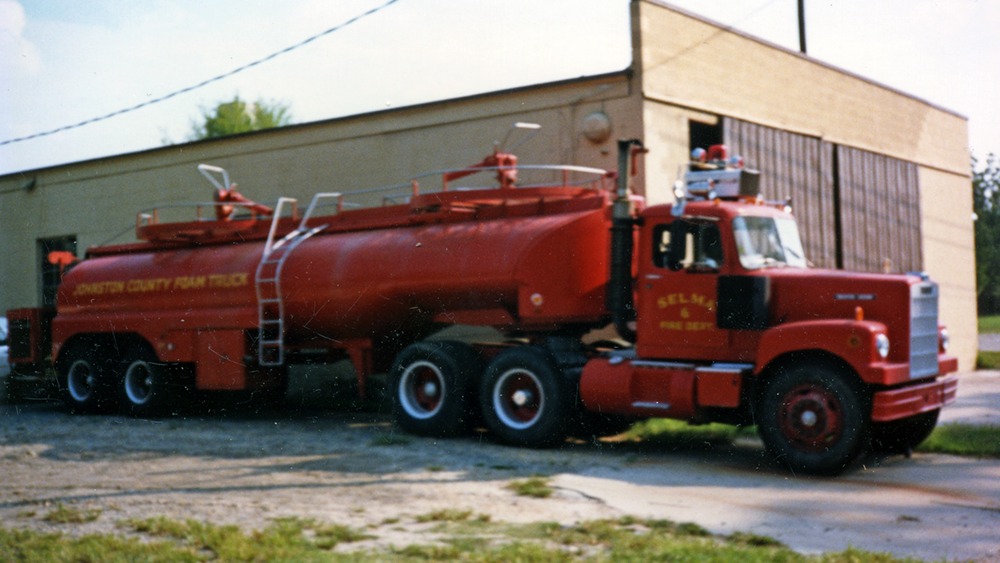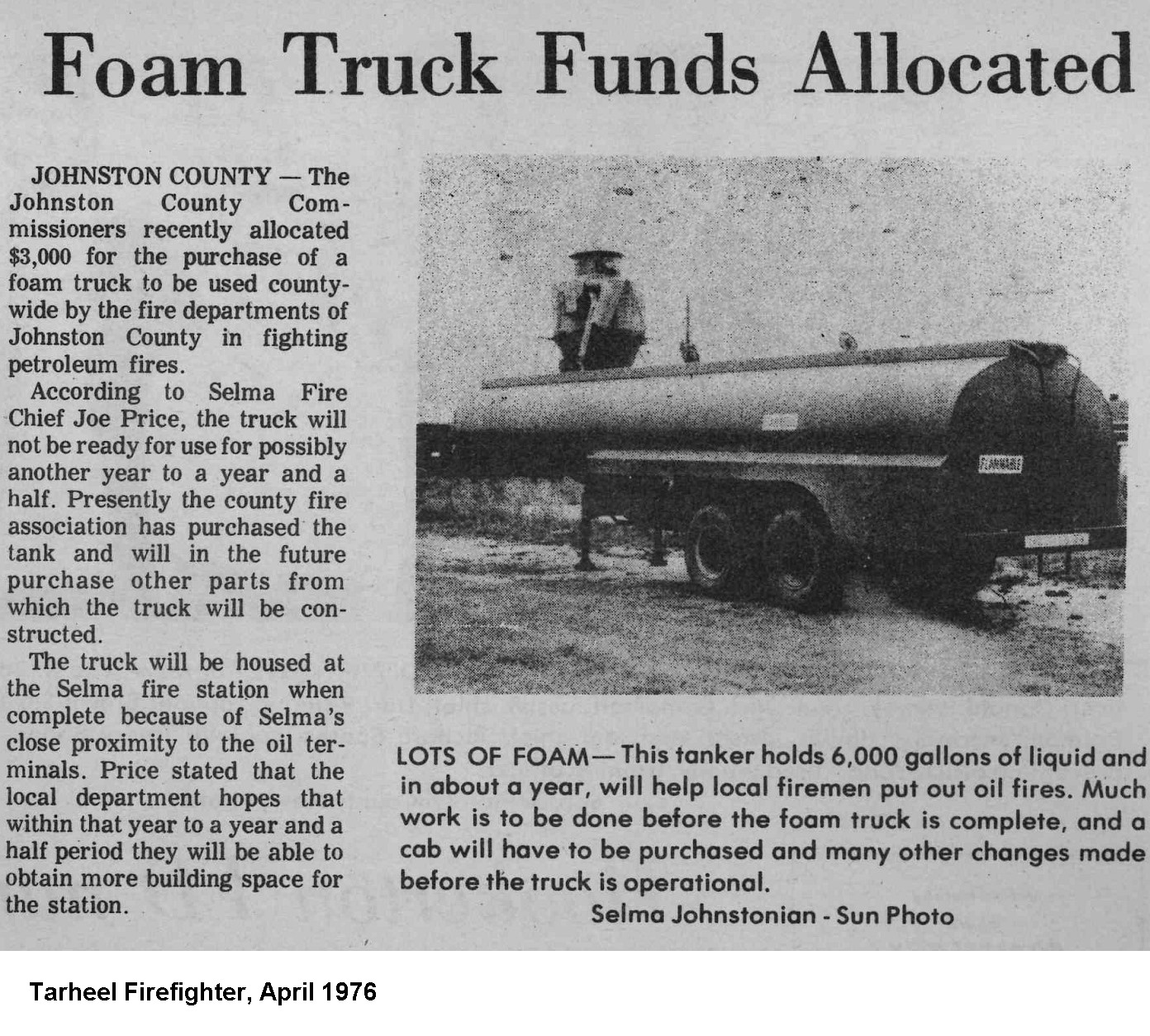This content was originally posted on Facebook in May 2020.
In the late 1970s, the first foam unit in Johnston County was created as a project of the Johnston County Firemen’s Association. The tractor-drawn tanker had a circa 1970 White 4000 tractor and a 1957 Heil tanker body, 6000 gallons, that had been modified to also carry 800 gallons of foam. It was also equipped with a pump and two turrets atop the trailer. The truck was placed in service in/around 1979 and housed at the Selma Fire Department, due to its proximity to the oil terminal.
Here’s the timeline:
- On July 15, 1974, the county board of commissioners received a request from the Johnston County Firemen’s Association (JCFA) for a foam truck to be added to the county’s roster of fire equipment. They stated that a fully-equipped foam truck would cost approximately $35,000. The board deferred action and asked two commissioners to investigate the possibility of federal funding for the project.
- On October 15, 1974, the board received a request for $2,000 to help the JCFA purchase materials and construct a “foam tank truck” for county fire protection. The group told the board that they planned to build the tanker themselves. The request was approved.
- On March 1, 1976, the board approved $3,000 for the JCFA to purchase a 1957 Heil tank trailer for the foam truck project.
- The April 1976 issue of Tarheel Firefighter reprinted a Johnstonian-Sun story, that reported that a 6,000-gallon tank body had been purchased by the JCFA. Selma Fire Chief Joe Price was quoted as expecting that 12 to 18 months of construction time would be required, to acquire a cab and add equipment.
- On November 1, 1976, the board approved the donation to the county of a 1974 foam trailer owned by the Johnston County Oil Jobbers Association. It was valued at $300.
- On March 13, 1978, the board approved $3734.49 to Carroll Machine Works in Smithfield, for work on the foam truck project.
- On June 14, 1978, the board was told that the tanker trailer was nearly completed. It was parked at M. B. Jones’ Garage near the oil terminal. The JCFA and the project committee were negotiating with oil terminal officials for help purchasing a tractor to pull the tanker. The board was also told that the tanker also had a water tank and could be used at any fire. The board was also asked for funds to sand and paint the tanker. They approved the funding of the estimated $200 cost.
- On October 2, 1978, the board was told that the JCFA has received no response from the major oil companies, regarding their request to help a tractor to pull the foam trailer. The trailer was “basically complete” except for sanding and painting. The board chairman was authorized to seek assistance from the major oil companies to “secure a tractor.” Also, Mike Jones had agreed to paint the tanker if paint was provided. And one of the commissioners would see if the county “could furnish a man to do the sanding,” though “the maintenance crew is short at this time.”
- On March 22, 1979, the board received a request that the county purchase the “chemical foam” for the foam tanker. The JCFA requested 1,000 gallons, with 800 gallons for the trailer and 200 gallons for back-up. Also, they had procured a tractor, donated by the Shell Oil Company. The board approved purchase of the foam, but any foam used at a fire should be replaced by the property owner.
- On January 6, 1981, the foam tanker responded to a burning fuel tanker on Highway 70-A in Selma. The truck overturned at night, while trying to avoid a collision with another truck. The resulting fire and explosion started fires on both trucks, sent flames rising hundreds of feet in the air, and melted a 23,000-volt power line that snapped and fell on the cab of a third truck, on nearby Interstate 95. All three drivers were injured, on seriously. Source: Winston-Salem Sentinel, January 7, 1981.
- On May 25, 1981, the board received a check for $4,418.70, for the one-half of the cost of the foam used at a “wrecked tanker” on Highway 70-A near Selma. The board “discussed this matter at length” and the board resolved to seek full compensation for the foam, if possible.
Later Foam Units
On June 8, 1992, the president of the Johnston County Fire Chief’s Association presented a request that the county purchase a “foam-spraying apparatus for fighting chemical fires and hazardous spills.” [Was the earlier truck no longer in service? TBD.] He stated that the county fire chiefs all agreed that the truck should be housed at Selma FD, “as that area is at greatest risk because of the oil terminals.” The unit would be available to all county departments, however. He cited the cost for the “foam unit” of $19,583. He also said that the JCFCA had found a two-truck flatbed truck, for mounting the unit, that cost $18,251.
The county emergency management director explained that the new truck should last a minimum of twenty years. Also, under “the regulations of S.A.R.A, the party responsible for a fire or spill would bear the expense of refoaming.” He also noted that the county had additional high-rise areas including the airport and two heavily travelled interstate highways. The board approved the purchase, which totaled $37,385.00.
As shown in a Lee Wilson photo from October 2011, the new unit was a 1991 Chevy Kodiak with a flatbed body. The truck was originally equipped with a hydraulic lift in the rear, which was detached and sold as surplus by the county. The sale of same was approved on September 8, 1992.
On July 1, 2013, the county approved transferring ownership of the truck to Selma FD, which had acquired a newer unit and planned to make the older truck a “support unit.” It was noted that the county and Selma FD had jointly operated the 1991 unit for the past 20 years. The decision included the provision that the equipment would be available for Johnston County Emergency Services and any county fire department “during times of emergencies.”
The newer unit was a 2007 Hino with a 2013 [?] flatbed body. It was delivered to Selma FD in March 2013. At the time it carried 1,500 gallons of foam concentrate on two pallets, plus a 2,000 GPM monitor.
Sources
Johnston County Historical Board Meeting Minutes



